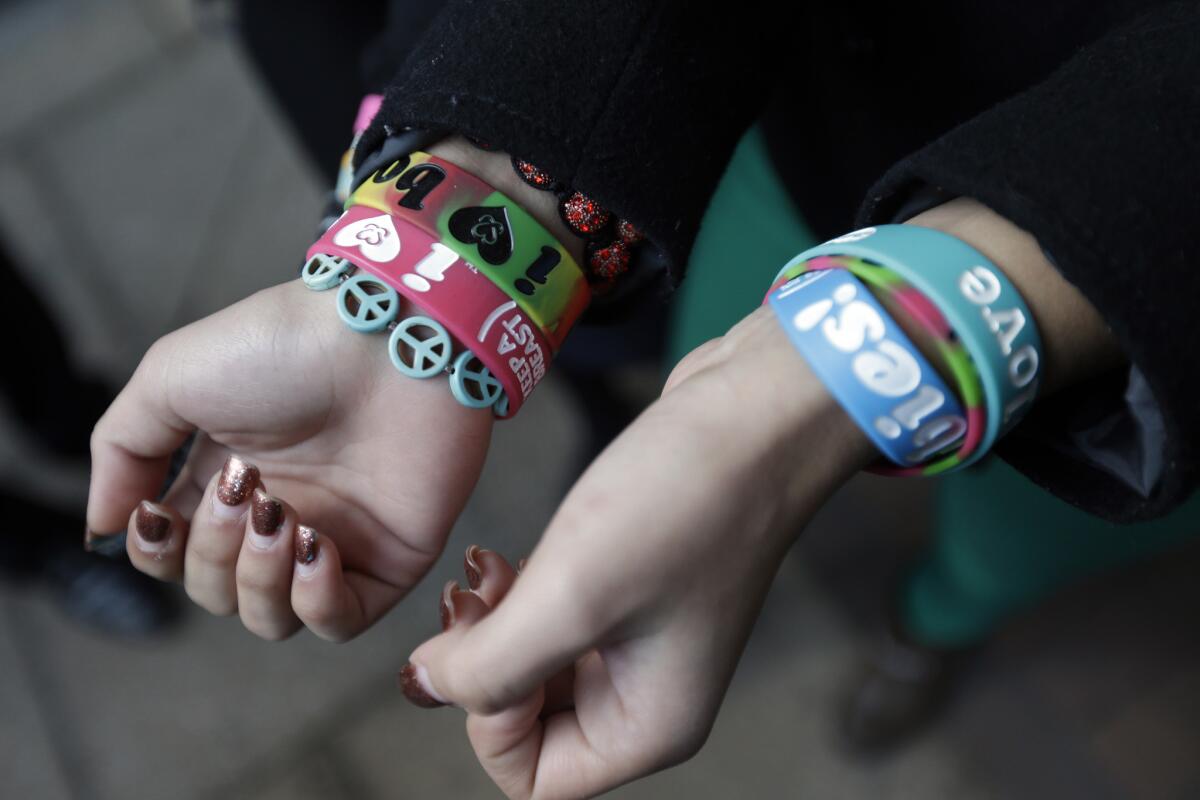The 3rd Circuit Court’s ‘boobies’ boo-boo

- Share via
“We expect our schools to educate young people not only in academics but in what constitutes respect ... in a civil society.”
The U.S. 3rd Circuit Court of Appeals in Philadelphia handed down a decision this month in a case involving two middle school girls who came to school wearing rubber bracelets bearing the message “I [heart] boobies!” The school suspended the girls, and their parents sued. The case made its way to the appellate court, and in a 9-5 decision, the 3rd Circuit found that the girls were wrongly disciplined, citing a well-known 1969 Supreme Court case, Tinker vs. Des Moines School District. The Tinker case involved students suspended for wearing black armbands to school in protest of the Vietnam War. The high court found they had the right to do so.
Central to Tinker is the assumption that students don’t “shed their constitutional rights to freedom of speech or expression at the schoolhouse gate.” This is a fundamental principle of democracy that most reasonable people would support.
What the courts have failed to do, however, is to take into account the real-world consequences of applying that principle, which is intended to support thoughtful adult discourse on matters of social and political relevance, to an adolescent social culture like a middle school.
The 3rd Circuit’s decision was based in part on its finding that “I [heart] boobies” is “ambiguously lewd” but is not “plainly lewd.” That distinction apparently has relevance in the adult world of constitutional law, but it completely falls apart in the social environment of a middle school playground.
“I [heart] boobies!” is a clever catchphrase devised by the good people at the Keep a Breast Foundation to heighten awareness about a very serious health issue for women and to generate revenue for its cause. It is clever precisely because it moves out of the statistical, medicalized awareness-campaign approach (“12.4% of women born in the U.S. will face breast cancer during their lifetime”) and into pop-culture ad speak, something more likely to get people thinking and talking about this serious health issue, albeit through the side door of the “ambiguously lewd.”
On the middle school playground, however, will that be the result if, say, a seventh-grade girl wears an “I [heart] boobies!” bracelet? Or will it incite considerably more ambiguously (and unambiguously) lewd commentary from other students, boys and girls, who are at that age struggling to establish social identity and dealing with their own emerging sexuality?
If a school condones the “ambiguously lewd” bracelets proclaiming “I [heart] boobies!” to be worn by girls, what kind of message is it sending to youngsters about the objectification of women? About the excessively sexualized body consciousness of young girls created by the fashion industry? The 3rd Circuit case involved girls wearing these bracelets. Does it make any difference if middle school boys wear them?
Freedom of speech is a precious democratic right and needs to be protected. But where children are involved, those protections need to be applied not only as a matter of constitutional law but as a matter of common sense, keeping in mind that values of respect, dignity and safety are not trampled in the process.
We live in a culture rife with examples of violence against women. Stories of sexual harassment in the military, in the workplace and even in government abound. We expect our schools to educate young people not only in academics but in what constitutes respect (including self-respect) and social responsibility in a civil society.
The courts are making that task nearly impossible when they fail to make basic, common-sense distinctions between the appropriateness of things like wearing a black armband and wearing a pink “I [heart] boobies!” bracelet. These issues are not only generations apart, they are psychologically and emotionally different in their impact on young people. The justices need to educate themselves on those differences in matters of students and 1st Amendment rights.
The 3rd Circuit decision puts teachers and administrators in a position of tacitly approving “ambiguously lewd” messaging and then having to cope with the collateral damage in the culture of the school that it will inevitably cause.
It is clear to me that it has been a very long time since any of the nine majority justices who decided this case have spent any time in a middle school. They are indisputably expert in constitutional law. They would do well to educate themselves more fully about the effective and appropriate application of that law when applied to adolescents in a school setting.
From 1993 to 2009, Roger Weaver was headmaster of the K-12 Crossroads School in Santa Monica. He now leads a consulting firm that works with nonprofits.
More to Read
A cure for the common opinion
Get thought-provoking perspectives with our weekly newsletter.
You may occasionally receive promotional content from the Los Angeles Times.






